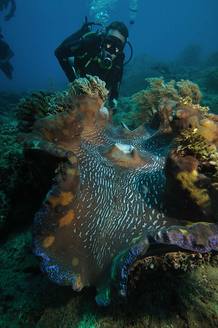
The Tridacna clam is the world’s largest . Their shells can reach 1.20 meters and 330 kilograms despite the animal. He lives in the Pacific Ocean Rick Hankinson
A walk on the beach alone is enough to find almost a hundred shells. They are as varied in sizes and colors. Since our prehistoric ancestors lovingly selected them for their beauty to make necklaces and bracelets. Today we continue to fascinate and delight made mostly of children is their rides inspected the admiration and curiosity. How they are made? How are they formed? The shells are shield the soft parts of molluscs bivalves, such as clams, mussels or oysters, and gastropods such as the shells. With them are protected from desiccation and predators, although there are specialized to break precisely these shields, as the oystercatcher, a bird with a harsh peak able to open the shells of bivalve stronger. As our cells build our bones, mollusks build their shells. These grow in thickness from the inside surface and edges , because they are the areas that are in contact with the mantle, which is the soft tissue of the animal responsible for depositing the material from which is made the shell. This hard cover is composed mostly by such a common molecule as calcium carbonate (stalactites for example are made of this substance) as embedded crystals in a pool of proteins and polysaccharides (called conchiolin). Mollusks extract calcium from their food, water, rocks and environment . Come through the blood flow to the mantle, which focuses and transforms them into crystals that are deposited in layers. Son three layers, composed of the same substance but in different proportions and crystallized differently. The interior is nacre or mother of pearl, formed by tight and neat layers, which captures the iridescent sheen jewelry designers. The middle layer is less compact. The outermost layer is located on the edge and is made mostly of conchiolin. Shells does not grow steadily . They do depending on environmental conditions and food availability. As in the tree rings in the shells can be read growth lines and find out if the mollusk has gone through some particularly adverse period. The color pattern depends on the species and serves to blend in and bring toughness to the shell. The pigments obtained through the food they eat, are metabolic waste products that accumulate in the shell. If you regularly eat the same shell have a uniform color. If not you will shell streaks and specks. Climate change is a threat to organisms with shells. The oceans absorb 25% of carbon dioxide emissions we emit. Carbon dioxide is a gas which in contact with water becomes acid. Something ominous for shelled organisms, since calcium carbonate dissolves in acidic water and disappears. The surface waters of the oceans have already acidified 0.1 pH unit from pre-industrial levels. Future acidification depends on the carbon dioxide that is emitted from now, but the expectation is that it will increase 0.4 more units by the end of the century. So the shells of a sea butterfly, which form part of the plankton in a laboratory simulation made by photographer David Littschwager to dispose National Geographic: David Littschwager / National Geographic Society  AMERICA VALENZUELA
AMERICA VALENZUELA
Shell or mother of pearl iridescent sheen
Oceans acids that dissolve the shells

![]()
![]()
No comments:
Post a Comment